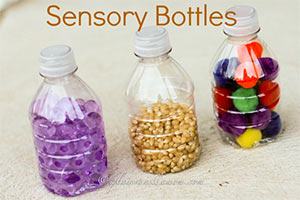Children are wired to receive and use sensory input from day one. This is why children will dive in hands first, exploring a new substance. The senses are their most familiar, most basic way to explore, process and come to understand new information.
Sensory play is important for young children, giving them endless ways to develop and learn. It helps children develop and improve their gross and fine motor skills, coordination, and concentration. It also teaches the child how to use all their senses to discover and explore their environment, and develop their imagination, creative thinking and ability to problem solve and experiment with solutions.

Under 1Year
Babies under one year of age can enjoy sensory play. Sensory play activities are those that stimulate a baby’s senses and encourage him to explore and discover things on his own. The activities listed here help to develop a baby’s muscles, fine motor skills, perception of color, depth and space.
Fill plastic bottles with water and other objects like pom poms, beads, sequins or popcorn kernels. Think about the different weights of the bottles or sounds they might make as he plays with them as well as how visually stimulating they are. As your child becomes more mobile, sensory bottles become good motivators for crawling. When your child bats at them, they roll away and your child will try to go after them!
Source: http://plainvanillamom.com/2012/05/sensory-bottles-for-little-ones.html

Toddlers
Did you know learning shapes is an early math skill? Children learn through their five senses and when we can target these senses toddlers are more easily able to internalize the learning experience. This activity teaches shapes in a hands-on way, encouraging your child to feel the shape, feel the curves and feel the pointed edges.
All you need is a puzzle which incorporates shapes, words, and color. Add the puzzle shape to a tub of rice. The shapes are colorful and the toddler can use color as a clue to finding and matching the shapes.
Source: https://www.funwithmama.com/shapes-hunt-sensory-bin/

Preschoolers
During the preschool years with most children it suddenly clicks that marks on a page have meaning, that these are words, words are made up of letters, and with these letters anyone can write. Getting good letter formation and the shapes of the letters is important, and sensory play can be a great learning tool for pre-writers.
Feather writing gives your child the opportunity to practice writing letters and shapes. There is very little preparation needed. Add salt to a tray or cookie sheet and placed a few feathers on the tray.
The feather was a good tool to use for pre-writing because children have a tendency to hold pens and pencils high up. But with the soft downy feathers at the base, you will be able to get him to hold the feather in a good grip to make the marks.
Start off with some shapes that form letters: lines, circles, diagonals and waves. Draw in one corner what you want your child to copy and then have him draw in the main part of the tray. Once done, smooth over the salt and start again. As your child masters the shapes, begin introducing letters and eventually words.
Source: https://rainydaymum.co.uk/feather-writing-playfulpreschool/